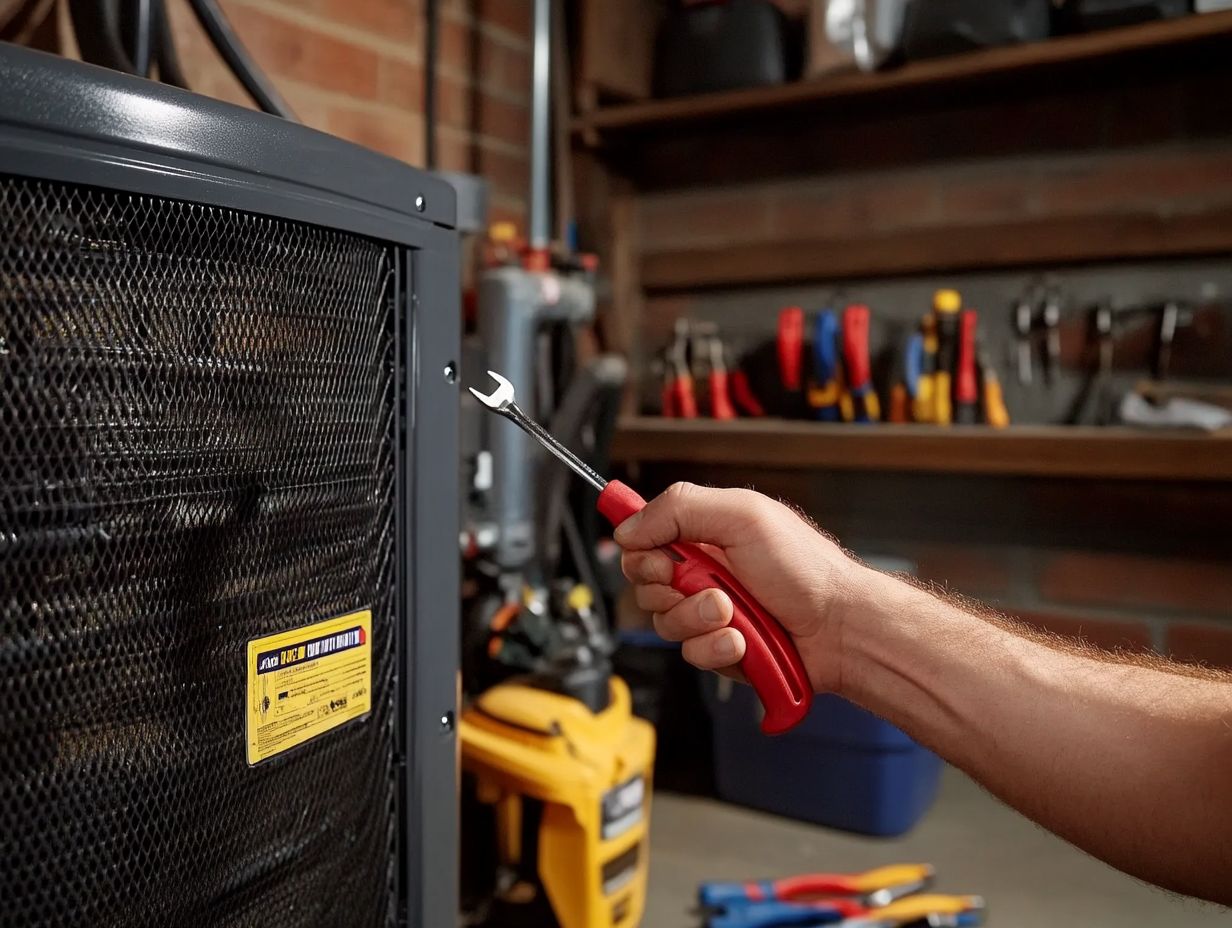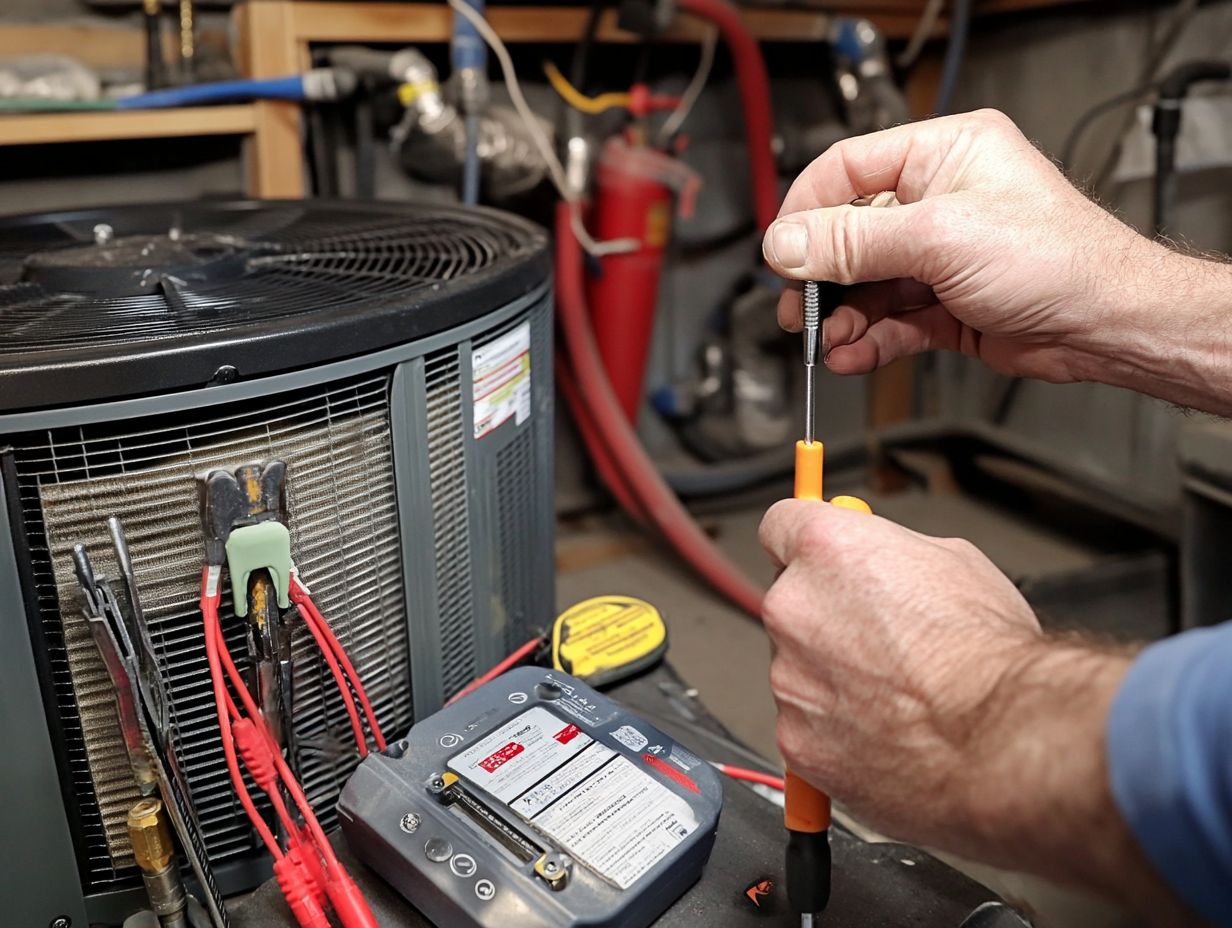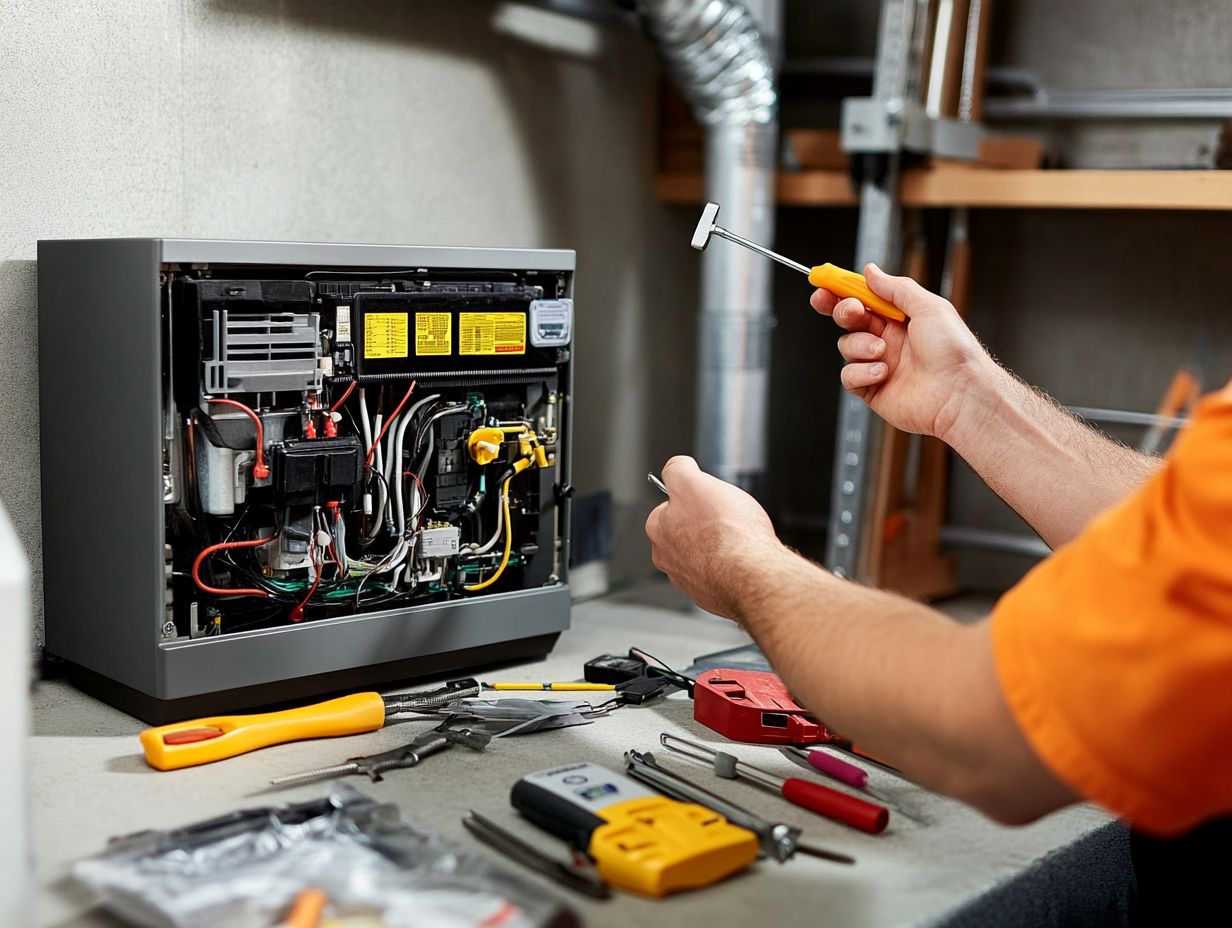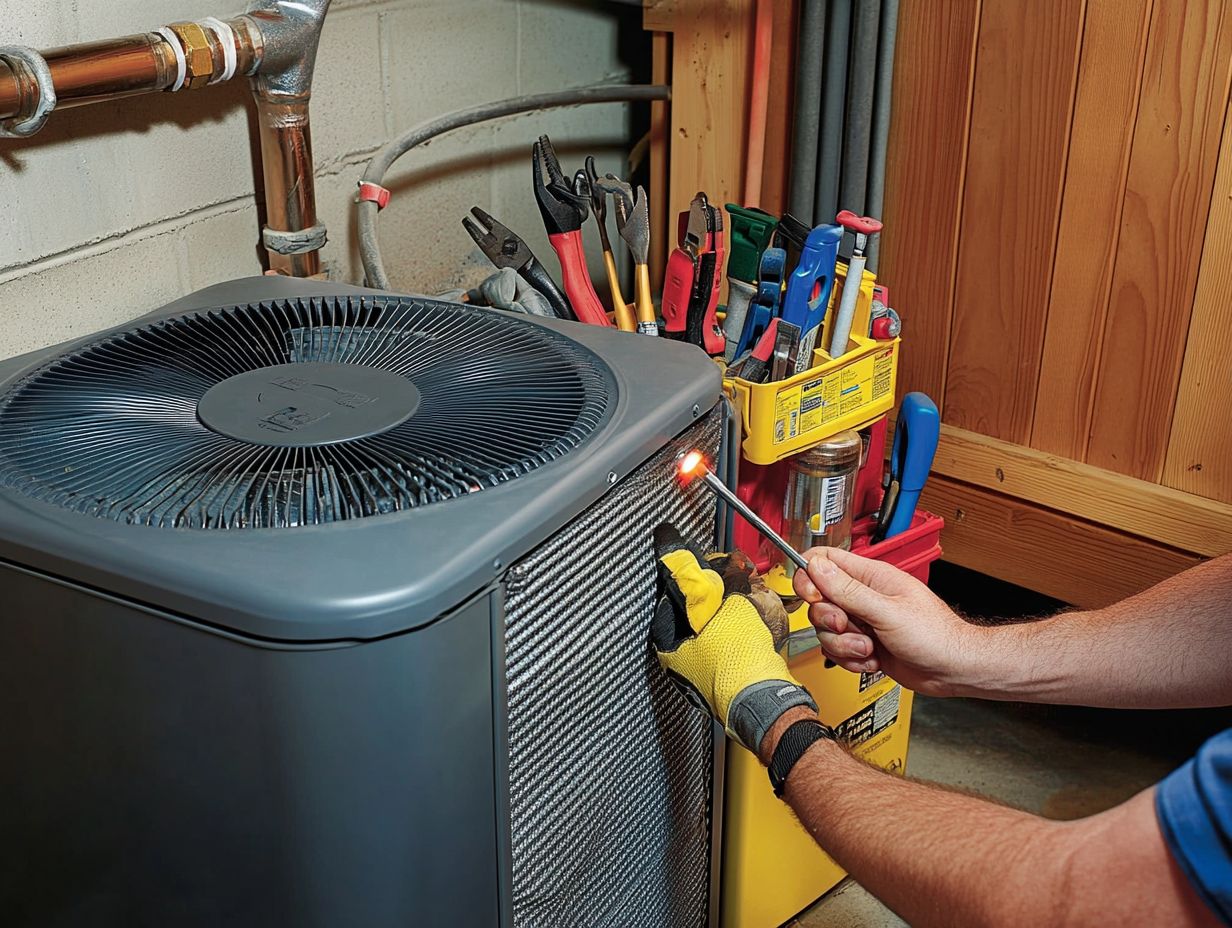When your HVAC system begins to show signs of trouble, like heating issues or cooling problems, it may be tempting to reach out to professionals immediately. However, many common issues have straightforward DIY solutions.
This article discusses the advantages of troubleshooting your HVAC system on your own, utilizing a troubleshooting guide and HVAC troubleshooting tips, as well as some important safety reminders.
We will address frequent problems such as low airflow, unusual noises, and uneven temperature distribution, providing quick fixes for each. Additionally, you will discover preventative maintenance tips to help keep your system operating efficiently throughout the year.
Take a moment to explore this information and equip yourself with the knowledge to tackle HVAC challenges effectively with the help of online tutorials and HVAC troubleshooting apps.
Benefits of DIY Troubleshooting

Engaging in DIY troubleshooting for your HVAC system can save both time and money. It enables you to address common issues such as airflow problems, refrigerant leaks, clogged filter issues, and electrical malfunctions without relying on expensive professional services.
With the right knowledge, you can perform quick fixes, enhance system efficiency, and maintain optimal indoor air quality, all while ensuring that your heating and cooling systems operate smoothly with proper temperature control and humidity control.
Taking on these projects can be surprisingly straightforward. For example, regularly checking and replacing air filters can significantly improve airflow and energy efficiency. Additionally, sealing ductwork can help prevent costly energy losses, thereby making a noticeable difference in your utility bills. Even minor electrical concerns, such as resetting your thermostat or checking circuit breakers, can often resolve interruptions in heating or cooling.
By familiarizing yourself with routine HVAC maintenance tasks, you can not only extend the life of your system but also create a more comfortable home environment. Being proactive not only keeps your system functioning effectively but also provides peace of mind, reducing the necessity for costly emergency repairs.
Safety Reminders
Safety should always be your top priority when undertaking DIY repairs on your HVAC system. Whether you are addressing electrical issues related to the circuit board, capacitor, or checking safety switches, having a clear understanding of the risks involved allows you to work with confidence and security.
Before starting any project, it is essential to familiarize yourself with all associated electrical components. This includes turning off the power at the breaker, understanding HVAC system components, and using insulated tools to prevent accidental shocks.
Wearing safety gear such as gloves and goggles is advisable to protect against physical hazards. It is also crucial to recognize the importance of correctly handling refrigerants and understanding their potential dangers.
Consulting user manuals, service manuals, and safety guidelines provided by the manufacturer can be invaluable resources. These documents will guide you through the repair process while helping to minimize potential mishaps with effective troubleshooting steps.
Common HVAC Problems and Quick Fixes

Understanding common HVAC problems, like air conditioner or furnace troubles, can truly give the power to homeowners to implement quick fixes and avoid expensive service calls. Whether it's troubleshooting air conditioning failures or addressing furnace repair issues, having a reliable troubleshooting guide can significantly enhance the efficiency and longevity of the system.
Such knowledge not only saves money but also fosters a greater sense of confidence in maintaining one's home comfort.
Low Airflow
Low airflow is a prevalent issue in HVAC systems that can significantly affect both performance and indoor comfort. Various factors can contribute to this problem, such as dirty air filters, blocked ductwork, airflow measurement errors, or malfunctioning blower fans.
When air filters become clogged with dust and debris, they restrict airflow, causing the HVAC system to work harder than necessary. This not only reduces efficiency but also increases the risk of premature system failure. Additionally, if ductwork is obstructed or improperly installed, it can further impede airflow and result in uneven temperature distribution throughout the space, affecting energy efficiency.
To effectively address these airflow issues, it is crucial to regularly replace filters, ideally every one to three months, depending on usage. Scheduling professional duct cleaning and HVAC diagnostics can also help remove blockages and ensure optimal air circulation. By taking these steps, one can significantly improve HVAC performance and foster a healthier indoor environment.
Noise or Vibration

Unusual noises or vibrations from your HVAC system can indicate potential issues that may require prompt attention. Identifying the source of these noise problems, whether it's a malfunctioning compressor, fan issues, or a faulty blower motor, can help mitigate further damage.
Different types of noises, such as rattling, squealing, or humming, can signal specific concerns. For example, a rattling noise might suggest loose components or a failing fan blade, while a squealing sound could indicate a worn-out belt that needs replacement. Excessive humming, on the other hand, often points to electrical problems within the compressor or pressure switch issues.
To troubleshoot these noises, it's advisable to begin with a visual inspection of all accessible components. Tightening any loose parts and checking for dirt buildup that may impede operation can often resolve the issue. Addressing mechanical problems early not only improves performance but can also extend the lifespan of the system.
Uneven Cooling or Heating
Uneven cooling or heating can lead to uncomfortable living conditions in one's home, often resulting from issues with the heat pump, thermostat, or even the ductwork. Identifying and addressing thermostat problems or implementing a zoning system can significantly improve temperature control and HVAC system efficiency.
When these systems are not calibrated correctly, some rooms may feel stifling while others remain uncomfortably cold. This issue is particularly prevalent in larger homes or multi-level spaces, where heat naturally rises and creates temperature disparities, affecting overall energy consumption.
To tackle this problem, it is essential to regularly assess the heat pump's performance and ensure it is operating efficiently. Homeowners may also benefit from professional thermostat calibration and HVAC repair services, which fine-tune the settings for optimal function.
Incorporating zoning systems offers tailored heating and cooling solutions, ensuring that every area of the home maintains a more consistent climate. This approach ultimately leads to enhanced comfort and improved energy efficiency.
Frozen or Leaking AC Unit

A frozen or leaking AC unit can significantly disrupt home comfort and may indicate underlying issues that need immediate attention. Common causes of these problems include refrigerant leaks, clogged drain lines, condensate drain issues, or faulty condensate pumps, all of which can compromise the efficiency of your HVAC system.
To effectively diagnose these issues, homeowners should begin by inspecting the system for any visible moisture or ice buildup, particularly around the evaporator coils. This could often indicate low refrigerant levels or airflow restrictions, which may require HVAC diagnostics.
Regular maintenance is essential. It's important to ensure that the air filters are clean to promote proper airflow and to check the drain pan for any blockages. Should you discover a refrigerant leak, it is crucial to contact a professional for repairs, as this task requires specialized tools for HVAC and expertise.
Maintaining the condensate pump and ensuring proper drainage can significantly extend the lifespan of the unit, helping to keep your home comfortable throughout the year with effective HVAC maintenance and seasonal maintenance practices.
Preventative Maintenance Tips
Preventative maintenance is essential for ensuring that your HVAC system operates efficiently all year round. By regularly cleaning the system, replacing air filters on time, and scheduling professional maintenance, you can avoid costly repairs and extend the lifespan of your heating and cooling systems, ensuring energy efficiency.
Taking these proactive steps will not only enhance performance but also contribute to the overall comfort of your environment.
Regular Cleaning and Inspection
Regular cleaning and inspection of your HVAC system are crucial for maintaining optimal performance and energy efficiency. By routinely checking system components and replacing filters when necessary, you can ensure that your heating and cooling systems operate smoothly.
Establishing a regular inspection schedule can help identify potential issues before they escalate, ultimately saving homeowners from costly repairs. It's a good idea to create a checklist that includes:
- Inspecting ductwork for leaks
- Verifying thermostat functionality and calibration
- Cleaning blower fans and inspecting the thermocouple
Additionally, checking refrigerant levels, performing pressure testing, and ensuring proper airflow through vents can significantly enhance the system's reliability. Homeowners should also remember to clear debris from outdoor units and maintain the surrounding area, adhering to HVAC best practices.
By following these straightforward yet effective steps, and using a maintenance checklist, you can contribute to greater HVAC longevity and optimal energy use, ensuring a comfortable living environment throughout the year.
Replacing Air Filters
Replacing air filters regularly is one of the simplest but most effective maintenance tasks for improving indoor air quality and enhancing HVAC performance. When filters become clogged, they can restrict airflow and reduce system efficiency, leading to airflow issues and common problems with the system, making it essential to stay on top of this task.
Generally, it is advisable to change air filters every one to three months, depending on factors like your location, the presence of pets, and overall air quality. Clean filters allow for unobstructed airflow, which not only ensures that the HVAC system operates at its best but also plays a crucial role in filtering out allergens, dust, and pollutants. This results in a healthier indoor environment, particularly benefiting those with respiratory issues. Additionally, regular air filter replacement helps in avoiding clogged filters, which can otherwise cause airflow measurement problems.
By prioritizing this straightforward yet vital maintenance step, homeowners can enjoy improved comfort, energy efficiency, and better temperature control, ultimately extending the lifespan of their HVAC units.
Professional Maintenance Recommendations
While DIY maintenance is certainly valuable, professional maintenance is essential for thorough HVAC service and accurate system diagnostics. Scheduling seasonal maintenance checks is a proactive approach that can help identify potential issues like furnace or air conditioner malfunction before they develop into emergency repairs, ensuring that your system operates at its best.
Engaging professionals for your HVAC needs brings several benefits, including their expert knowledge and advanced diagnostic tools, which can accurately identify inefficiencies or emerging problems such as refrigerant leak or electrical problems. They provide a range of services, such as regular inspections, component cleaning, and timely repairs, all of which not only enhance system performance but also extend the lifespan of your equipment.
Trained technicians are knowledgeable about industry standards and safety regulations, offering reassurance that maintenance is carried out correctly. They also address ductwork and insulation issues to optimize efficiency. Regular professional service can also boost energy efficiency, resulting in lower utility bills and a more comfortable indoor environment.
.2509031213252.webp)

.2506100744000.png)

